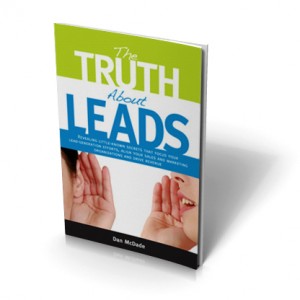I spent 15 months as a sales manager, which was just long enough to learn how little aptitude I had for the job.
The experience did give me an appreciation for the difficulty of selling, though. In 20 years as an editor I had developed an attitude that’s common for people who produce products: I believed that most salespeople were overpaid, under-worked and basically lazy. My 15 months of hell taught me otherwise, and that’s why I was curious when Dan McDade sent me a copy of The Truth about Leads.
 McDade Is an entrepreneur whose company, PointClear, helps businesses improve their prospecting and lead nurturing. The Truth about Leads is a short book – only 101 pages – but it’s packed with sales wisdom. Some of McDade’s advice will be difficult for sales managers to hear, but it’s hard to argue with his logic.
McDade Is an entrepreneur whose company, PointClear, helps businesses improve their prospecting and lead nurturing. The Truth about Leads is a short book – only 101 pages – but it’s packed with sales wisdom. Some of McDade’s advice will be difficult for sales managers to hear, but it’s hard to argue with his logic.
McDade believes that most companies invest far too much in lead generation and far too little in lead qualification and nurturing. Salespeople are too quick to discard leads that don’t show immediate potential, preferring to focus on the small number of opportunities they can close quickly. In doing so, they squander opportunities to pursue long-term relationships that can yield far more revenue over time.
This behavior contributes to the chasm that exists between marketers and sales people in many organizations, particularly B2B companies. Marketers throw large numbers of leads over the wall to sales because that’s what they’re paid to do. Sales people don’t effectively follow up on longer-term opportunities. Each party complains about the other’s incompetence.
McDade (left) lays equal blame on both parties, concluding that the net effect is “about 95% of generated leads are not effectively pursued by sales.” Lead nurturing takes time and persistence that few sales people have and fewer sales managers tolerate. The reality is that it may take 10 to 12 calls and e-mails to get the attention of a single prospect. Most sales people give up after three. And even that is only the beginning. Ten percent of qualified leads close within three months, but 45% will close within a year if they are properly nurtured. The good news is that the leads that take the longest to close are the most likely to be good sources of repeat business. Once they’re convinced, they’re all in.
McDade is particularly critical of the cost-per-lead (CPL) metric that is commonly used to measure marketing effectiveness. CPL drives marketers to outsource demand generation to unskilled contract telemarketers or to purchase lists of dubious quality. These tactics can generate a lot of names, but not many qualified leads. “Fewer than 7% of leads passed to sales by marketing should be,” McDade states.
In his view, lead qualification is a far more productive investment than lead generation because it focuses sales resources on the opportunities that have the highest conversion potential and the greatest long-term value. Lead qualification also demands cooperation between marketing and sales, which is something most companies badly need. Marketers should be rewarded for making sales successful, not throwing names over a wall.
The Truth about Leads has numerous other tactical gems that salespeople will appreciate. The section on selling to pain rather than opportunity is right on the mark as is the persuasive case McDade makes against “appointment setting,” a practice that focuses sales resources on meeting with people who have a lot of time on their hands.
The Truth about Leads does what a good business book should: Defies conventional wisdom with logic born of experience. Reading it is two hours well spent.
